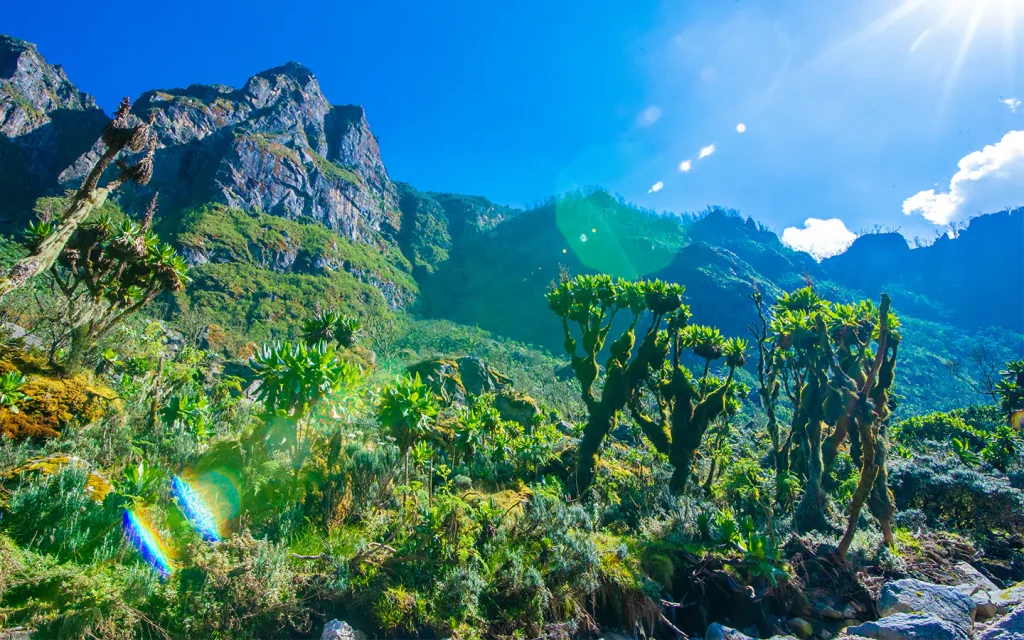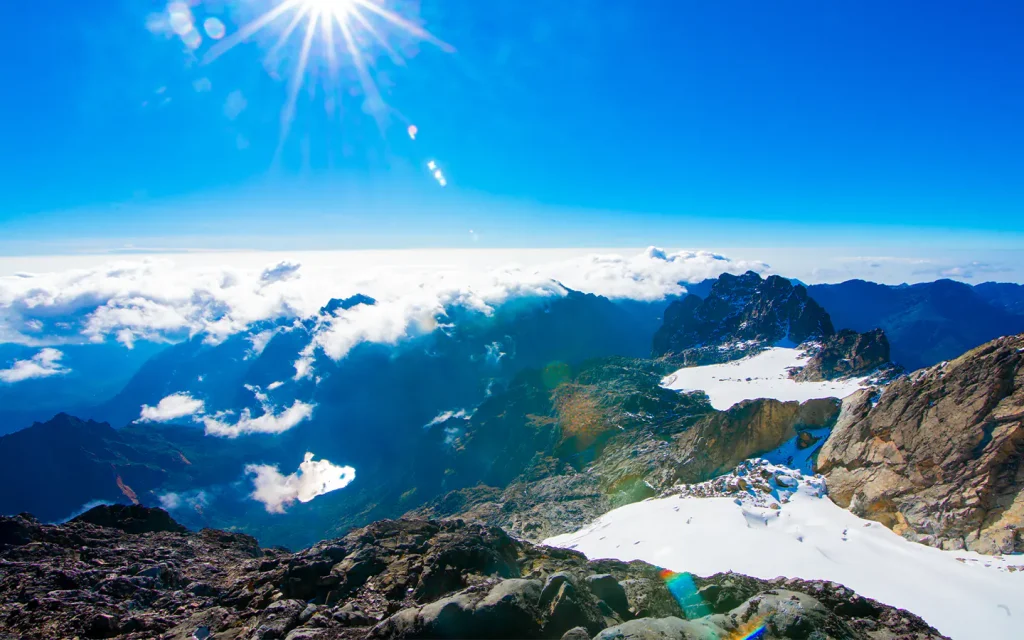
Rwenzori Mountains National Park also known as the mountains of the moon as described in 150AD by Ptolemy a Greek geographer and also proclaimed by many as remarkable snow-capped mountains. This was also confirmed by henry Morton Stanley who affirmed the ancient proclamation in 1889 when he visited Uganda and went to the Rwenzori mountains.
The Rwenzoris are indeed a historical land mark that no one should ever miss to experience while on a Uganda safari. Margarita is Rwenzori’s highest peak at 5109m above sea level and it is ranked as the third highest peak after Mount Kilimanjaro and Mount Kenya.
Despite being close to the lake, Rwenzori Mountains are covered by snow structured in form of ranges which pose a quite challenging experience to climb. These glacier mountains also led to the formation of river Nyamwamba. Rwenzori national park is home to at least 217 species of birds of which 19 species are only found in the Albertine rift and the vegetation ranges of the park is very impressive. Apart from Margarita peak, Rwenzori Mountains national park features other peaks like Mt Baker (4,843m), Mt Emin (4,798m), Mt Speke (4,890m), Mt Luigi di Savoia (4,627m) and Mt Gessi (4,715m). Mount Rwenzori is surrounded by communities like the Bamba, Bakonzo whose lifestyle is adapted to the mountainous ecosystem.



Wildlife
Because of their altitudinal range and the nearly constant temperatures, humidity, and high insolation, the Rwenzori Mountains support the richest montane flora in Africa.
There is an outstanding range of species, many of which are endemic to the Albertine Rift and bizarre in appearance. The natural vegetation has been classified as belonging to five distinct zones, mainly determined by altitude and aspect. The higher altitude zones, covered by heath and Afro-alpine moorland, extend from around 3,500 m to the snow line and represent the African continent’s rarest vegetation types. Significant species of the Rwenzoris include giant heathers, groundsels, lobelias, and other endemics.
In terms of fauna, the Rwenzoris have been recognized as an Important Bird Area with 217 bird species recorded to date (several believed to Albertine Rift endemics , a number expected to increase as the park becomes better surveyed. The montane forests are also home to threatened species such as the African forest elephant, eastern chimpanzee, and l’Hoest’s monkey. The endangered Rwenzori black-fronted or red duiker, believed to be a very localized subspecies or possibly a separate species, appears to be restricted to the Park.
By Agripio at English wikipedia CC BY-SA 3.0
The Rwenzori Mountains National Park provides stunning views of the glacier and snow-capped mountains just miles from the equator, where it is contiguous with the Virunga National Park in the Democratic Republic of Congo (DRC). The Park includes a much larger alpine area covering 99,600 ha, of which 70% lies at over 2,500 m in height.
The Rwenzori Mountains are the most permanent sources of the River Nile and constitute a vital water catchment. Their multitude of fast-flowing rivers, magnificent waterfalls, and stratified vegetation make the property exceptionally scenic and beautiful. The mountains are well-known for their unique alpine flora. The Park also supplies local communities with various wild resources and is an important cultural heritage.
On the foothills of the mountain, you will witness farmlands and on top of the distinctive mountain flora, which has attracted a great deal of fauna and delivering a fantastic picturesque to the travel enthusiasts. Arrive at the top of the mountain and behold the majestic snow-capped peaks that will leave you breathless.
Rwenzori Mountains National Park is situated in Western Uganda in the East African Rift Valley and also straddles to the Democratic Republic of Congo and its conservation area known as Virunga National Park.
The Ugandan government owns Rwenzori Mountains National Park through Uganda wildlife authority . It is protected, although a board of trustees may sanction extraction. Kasese, 437 km (260 mi) west of Uganda’s capital Kampala, is the park’s gateway. The town has hotels and lodges, while the park has camping, a good trail network, and huts for hikers. The park has trekking and climbing routes, several with unusual scenery. The most popular trek is a seven-day circuit of the park.
Climbing the Mountains of The Moon
Two routes lead into the Rwenzori peaks. The more established option ascends the Mubuku and Bujuku valleys from Nyakalengija to the Central Circuit that winds between the prominent peaks. The other route runs up the Nyamwamba Valley above Kilembe near Kasese. The expeditions on the Rwenzori are organized and managed by Rwenzori Trekking Services and Rwenzori Mountaineering Services.
Rwenzori Mountaineering Services (RMS) is a local community tourism group established to provide local Bakonzo people with the money to benefit from tourism on the mountain that has for centuries been central to their existence and cosmology. Local men are employed as guides and porters, and profits are supposed to be invested in community projects.
They do not, however, have a monopoly on the trail. The alternative is to skip Nyakalengija altogether and climb the Kilembe Trail, a concession for which UWA allocated to Rwenzori Trekking Services (RTS). Allied to the Kampala Backpackers, RTS allows you to concentrate on enjoying the rain and mud to the full.
Rwenzori Trekking Services offer a variety of mountain treks and climbs using a combination of trails along (and between) the Nyamugasani, Kamusoni, and Nyamwamba river valleys. The distance to the peaks is more incredible than along the established Central Circuit, and an ascent of Margherita will require nine to ten days rather than eight or nine.
An alternative ascent from Kilembe takes you through routes that run through pristine landscapes — unvisited by hikers for decades — of astonishing beauty; the Nyamugasani Valley contains a remarkable string of eight lovely glacial lakes.
Incidentally, as a tourist trail, the Kilembe route is somewhat older than the established Nyakalengija Trail. The Nyamwamba Valley was first ascended in 1895 by Professor Scott Elliot, 11 years before the Italian Duke of Abruzzi pioneered the more direct route along the Bujuku Valley.
The base camp for the Kilembe Trail is the Rwenzori Trekkers hostel at the upper end of Kilembe Town, 14km from Kasese and 2km beyond the market and the bridge. A boda-boda from Kasese costs Ush5,000 (Ush10,000 with a big backpack!). A Special hire costs Ush50,000.
The most recommended route is the eight-day round trip to the summit of the 4,842m-high Mount Bake. A more extended expedition can reach Mount Stanley, while shorter hikes of one to five days’ duration can be made to appreciate the scenery.
The cost of an eight-day hike with RTS to the summit of Mount Baker is US$1,200. It covers everything — park entrance, one porter, tented or but accommodation, and food (excluding your high-energy snacks). Climbing gear, if required, is charged separately. A nine-day ascent of Margherita (Mount Stanley) instead of Mount Baker will cost US$1,280.
It’s helpful to note that UWA fees are per day and not (as on the Central Circuit) per section. While ascents of the Kilembe Trail move between fixed overnight spots to ensure acclimatization, on the descent, it’s possible to descend two stages in a day and save a bit on the prices above.
Shorter treks up to Mutinda or Lake Kopello cost slightly less; budget for about US$122 per day, again full board.
Rwenzo Mountaineering services from Ntakalengija will make all arrangements whether you book directly through their offices in Kasese or at UWA headquarters in Kampala. The seven-day, six-night hike along the Central Circuit loop trail with RMS costs US$780/705 for foreigners/foreign residents and US$1,250/$1,530 for the seven/nine-day trip to the top of Mount Stanley.
Additional days on the mountain cost US$120 per day, and you can climb other peaks at US$150 per peak. Rates include two porters, accommodation, and park entrance fees ($35 per person/day) but exclude food.
You can also book through most local tour operators, most of whom will deliver you to Nyakalengija and turn you over to RMS. The exception is the Adventure Company which will supply groups of eight-ten with an experienced expatriate expedition leader with technical mountaineering skills, first-aid training, and cooking skills.